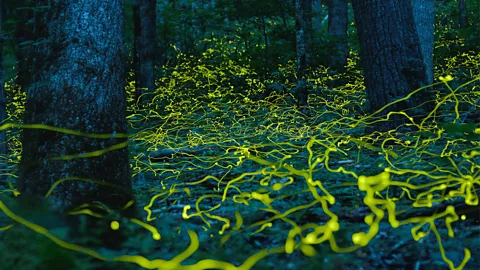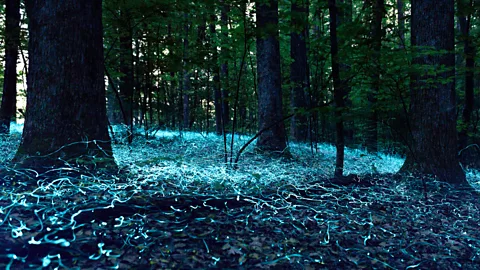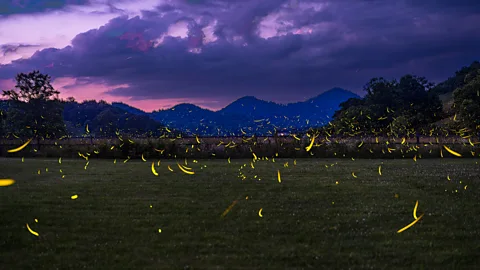Can rare 'blue ghosts' help Asheville rebuild?
 Tim Reaves/ Visit Asheville
Tim Reaves/ Visit AshevilleEight months after Hurricane Helene devastated areas of North Carolina, locals hope their rarest residents – glowing "blue ghost" fireflies – can help bring visitors back.
If you walk quietly through the woods of western North Carolina any time from now until mid-June, you may catch a glimpse of an eerie sight: dozens, sometimes hundreds, of tiny blue lights floating silently along the forest floor.
These are Phausis reticulata, known as "blue ghost" fireflies; a rare species of bioluminescent beetle that can only be found in the Southern Appalachian mountains. Their emergence, and that of their flashy relatives Photinus carolinus, commonly known as the Smokies synchronous firefly, draws thousands of people to the area each spring.
Asheville, a small artsy city in North Carolina, is a key gateway for firefly watchers, offering access to nearby Great Smoky Mountains National Park, Pisgah National Forest, DuPont State Recreational Forest and a few other heavily wooded areas in western North Carolina and eastern Tennessee. But this year, the glow carries added meaning. In September 2024, the remnants of Hurricane Helene tore through the region, causing widespread flooding that destroyed homes and businesses and inflicted an estimated $53bn of damage across North Carolina. Though Asheville officially re-opened to visitors at the end of last year, tourist numbers have yet to rebound entirely.
Now, locals hope that this year's firefly season can help put the city back on the map.
"Fireflies are really important [to tourism here], and while we have sold out now for most of our experiences, that would have [usually] happened months ago," said Nicolle Will of Asheville Wellness Tours, which leads immersive firefly and wellness experiences. "We were still down 70% when we reopened in November, comparing it to the same period [in previous years]."
 Bobby Bradley/ Visit Asheville
Bobby Bradley/ Visit AshevilleThere are more than 2,400 firefly species around the world – at least 10 of which are native to this region – but blue ghost fireflies are the rarest. Like all fireflies, these tiny beetles use bioluminescence to attract mates. Blue ghosts, however, emit a continuous blue light instead of the more intermittent bright-green flashes of common fireflies. Synchronous fireflies, meanwhile, coordinate their flashes, temporarily lighting up the forests with their display. Fireflies have long been a major tourist draw here, as visitors from across the country and the world make the trip to witness this magical phenomenon for themselves.
Firefly etiquette
Keep light to a minimum: Do not take photographs or use mobile phones as bright lights can confuse fireflies and interfere with their mating process. Your camera likely won't pick up the bugs' blue hue, anyway. It's also best to arrive early to let your eyes adjust to the light. Find one spot to observe from so you don’t have to walk around in the dark; if you must move around, use a torch with a red-light filter.
Stay on paths: Fireflies live and lay eggs in the leaf litter; disturbing it can damage their habitat and walking on it can kill females and juveniles who live there.
Avoid insect repellent: Visitors are asked to forego spraying mosquito repellent while in the forest as it can also repel or even kill fireflies. Instead, apply before leaving home.
Do not catch them: As heartbreaking as it sounds to people who did it as a child, catching fireflies is not recommended. It can interfere with their mating processes and lead to unintentional harm of the fireflies or their habitat. Instead, find a good vantage point from which to enjoy the show.
Because of their popularity, the National Park Service holds a firefly viewing lottery for Great Smoky Mountains National Park as well as nearby Congaree National Park in South Carolina. This limits access to peak viewing sites in order to protect both the beetles and their habitat. Numerous local businesses also take advantage of the visitor boom, offering smaller group tours both in Pisgah Forest and on private land. These tours are usually booked out far in advance of the season – though that wasn't the case this year.
However, one reason for optimism is that the fireflies seem to have weathered the storm well. "The floods here caused a lot of human damage… a lot of damage to our homes, to our roadways, to our cities. But while there's a lot of trees that are down, those are small scale types of disturbances," said Jennifer Frick-Ruppert, a naturalist, writer and professor of biology and environmental science at Brevard College. "Over eons, there have been floods, there have been fires, there have been tree falls. It's when the forest gets removed… that's when the fireflies are gone."
More like this:
• From sea sparkles to fireflies: Chasing Australia's 'big four'
Despite their ethereal glow, these tiny beetles are anything but delicate. People who gathered them in jars as children might be surprised to know they're considered fierce predators in the leaf litter where they live. "They're like little sharks moving around in there," said Frick-Ruppert. They'll eat anything smaller than them that they can catch."
 Radim Schreiber
Radim SchreiberEven so, many species of fireflies are facing a massive decrease in numbers due to habitat loss, pesticides and global warming. Light pollution is also a major problem, especially for blue ghosts, as it can interfere with their mating rituals. That's why, Will says, it's important to follow the guidelines when visiting.
"[Blue ghosts are] super sensitive to light," she said. "If you're more familiar with [common] fireflies, they're blinking in the backyard, they don't care that your porch light is on. But [blue ghost] fireflies, if your phone screen lights up… they're like, 'nope'."
Though many of the beetles' hiding spots can be found online, Will encourages visitors to go with a local guide, both for a more enjoyable experience and to support recovery. "It's a huge morale boost to have people frequent our small businesses," she said. "Asheville [is] unique in terms of the concentration of locally owned businesses here. Almost anywhere you turn, you're going to be supporting someone who has been through this traumatic period. And what we do all day, every day, is share [our community] and hope to connect people more deeply to Asheville and the region."
--
If you liked this story, sign up for The Essential List newsletter – a handpicked selection of features, videos and can't-miss news, delivered to your inbox twice a week.
For more Travel stories from the BBC, follow us on Facebook, X and Instagram.
